Bazèga is a region of Burkina Faso that is home to a wide variety of birds. The natural environment of Bazèga provides a habitat for many species of birds, including several endemic species.
Over one hundred species of birds can be found in the region, including species of raptors, ducks, and waders. As well as providing a great range of bird species, Bazèga is also an important area for migratory birds.
During the rainy season, many species of waterbirds can be seen in the region. Birdwatching in Bazèga is an increasingly popular pastime and provides an insight into the variety and abundance of bird species in the region.
1. Helmeted Guineafowl
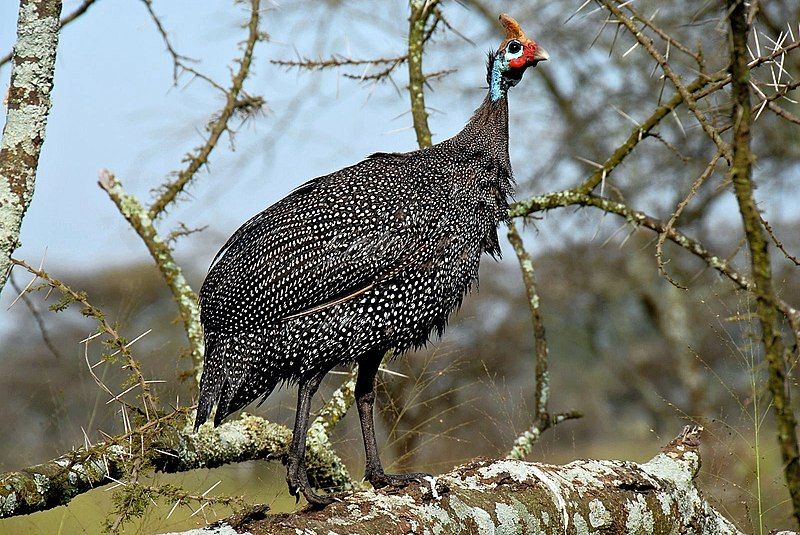
The helmeted guineafowl is the most well-known species out of the Numididae family of guineafowl birds. It is the only member of its genus Numida. This bird is native to Africa, mainly inhabiting areas south of the Sahara desert.
It has also been introduced to the West Indies, North America, Colombia, Brazil, Australia, and Europe, usually as a domesticated species.
This species of bird is fairly popular as a farmyard animal and is typically kept in captivity for its eggs or as a source of entertainment. The helmeted guineafowl is a hardy bird, able to survive in a variety of climates and habitats, and is a frequent sight in rural areas.
Its adaptability has allowed it to thrive in many different regions, both in the wild and in captivity.
| Kingdom | Animalia |
| Phylum | Chordata |
| Class | Aves |
| Order | Galliformes |
| Family | Numididae |
| Genus | Numida |
| Species | N. meleagris |
2. Common Ostrich
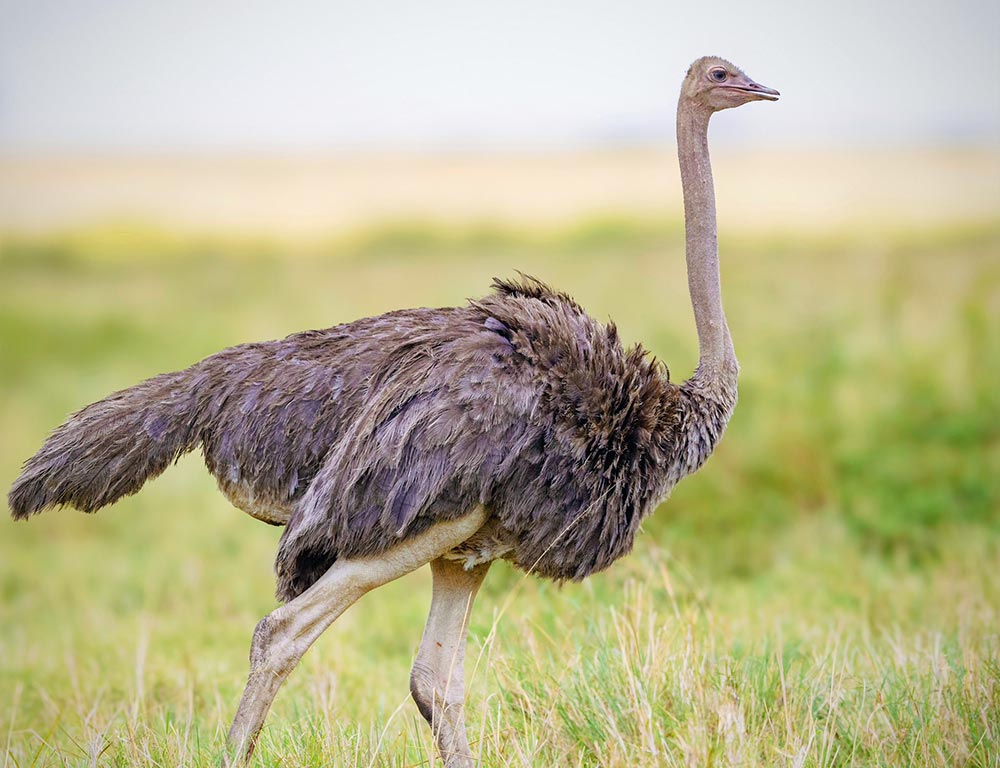
The common ostrich is the largest living bird in the world and is native to certain areas of Africa. It’s the only living species of the genus Struthio and is part of the ratite order of birds. It is flightless and is capable of running faster than any other bird.
Ostriches have long legs and a long neck and can grow up to 9 feet tall. They typically weigh around 300 pounds. The feathers of an ostrich are mostly brown, with white and black stripes on the wings and tail.
Ostriches have long, powerful legs with two toes on each foot, and can run up to 40 miles per hour. They also have sharp claws which they use for digging and grooming. Ostriches are omnivores, meaning they eat both plants and animals.
Their diet consists of insects, small mammals, fruits, leaves, and roots. Ostriches live in large flocks and are highly social creatures, communicating through a variety of vocalizations. They can live up to 40 years in the wild.
| Kingdom | Animalia |
| Phylum | Chordata |
| Class | Aves |
| Order | Struthioniformes |
| Family | Struthionidae |
| Genus | Struthio |
| Species | S. camelus |
3. Osprey
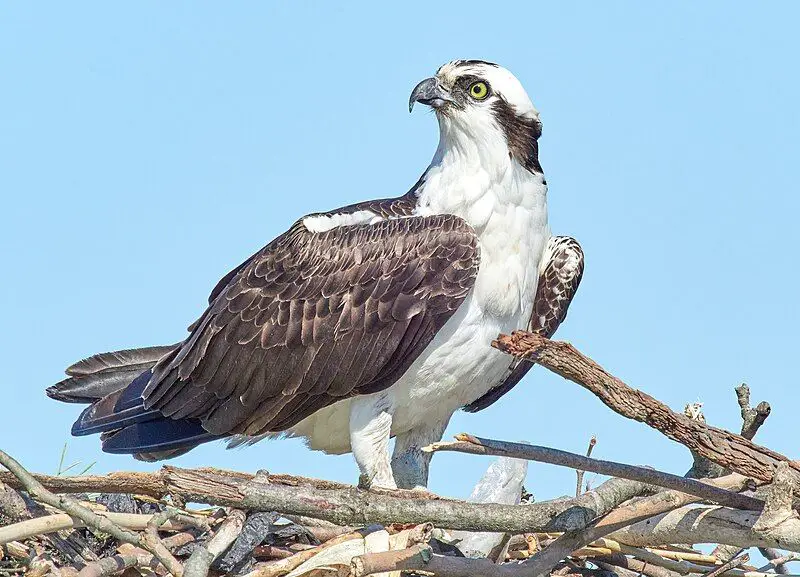
The osprey is an impressive bird of prey, which is also known as a sea hawk, river hawk, and fish hawk. It is widely distributed across the globe and is active during the day, primarily feeding on fish.
This large raptor has a wingspan of up to 180 cm and a length of over 60 cm, making it quite an impressive sight. Its upperparts are brown in color, while its head and underparts are mostly grey. Its hooked beak is also grey and is perfect for tearing apart its prey.
Its diet of fish makes it an important predator in many environments, helping to maintain a healthy balance in the local ecosystem.
| Kingdom | Animalia |
| Phylum | Chordata |
| Class | Aves |
| Order | Accipitriformes |
| Family | Pandionidae |
| Genus | Pandion |
| Species | P. haliaetus |
4. Grebes
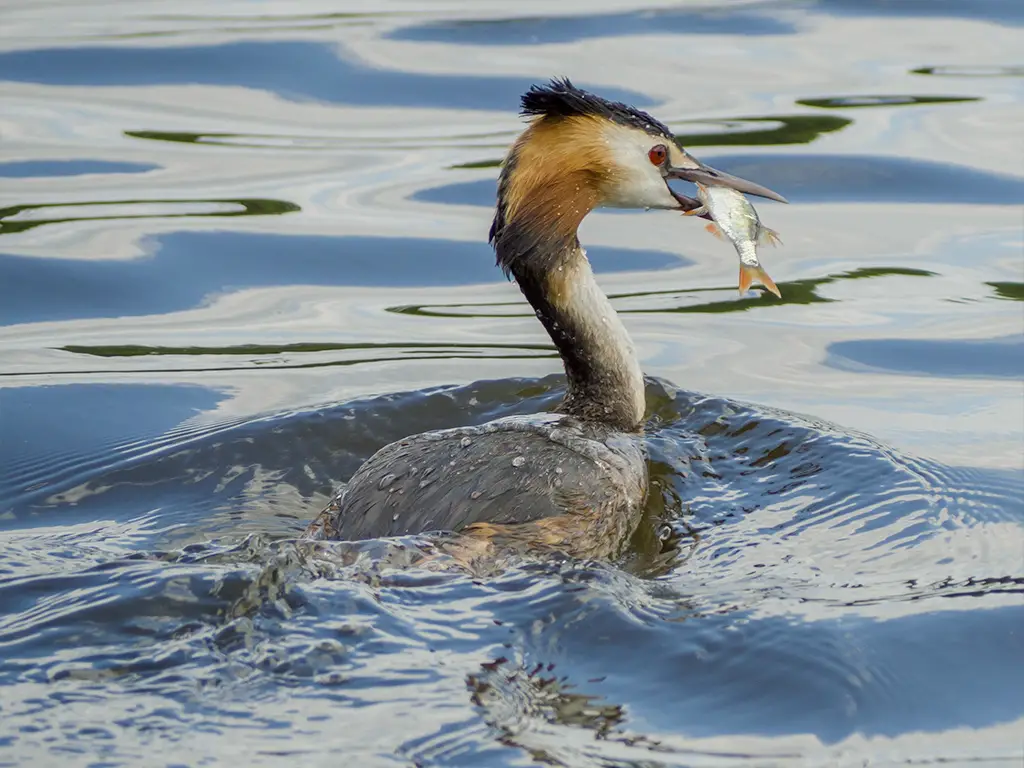
Grebes are a type of bird that belongs to the order Podicipediformes, which is a group of diving birds. They are typically found in freshwater environments, though some species migrate to marine habitats during the winter or migrate seasonally.
Grebes can fly, although there are a few flightless species, mainly those that inhabit stable lakes. These flightless species usually remain in the same area for their entire lives, though they may still migrate seasonally.
Grebes are highly adapted for swimming and diving, with their long legs allowing them to move swiftly through the water and their webbed feet providing extra traction. They have dense feathers that help them trap air so they can stay submerged for extended periods.
Grebes are omnivorous, meaning they feed on a variety of aquatic organisms such as fish, insects, and crustaceans. They are also known to scavenge for food and even hunt on occasion.
| Kingdom | Animalia |
| Phylum | Chordata |
| Class | Aves |
| Clade | Mirandornithes |
| Order | Podicipediformes |
| Family | Podicipedidae |
5. Glossy Ibis
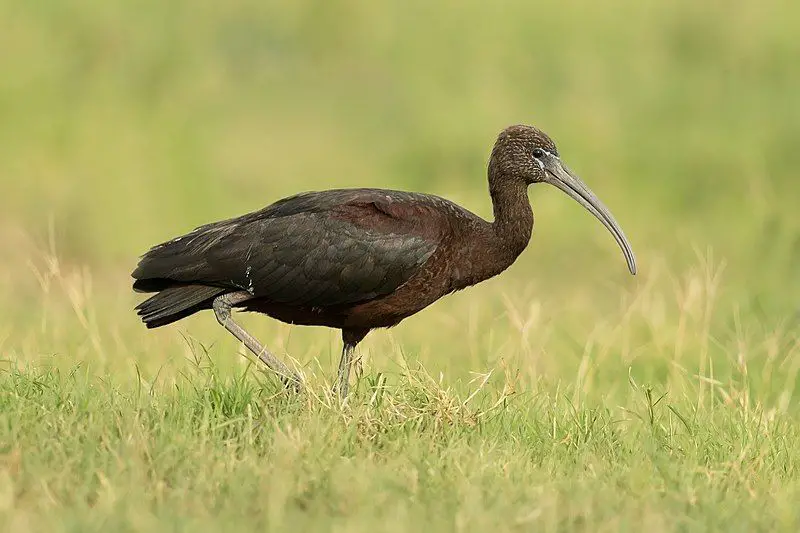
The glossy ibis is a unique and interesting species of water bird. It belongs to the order Pelecaniformes, which includes pelicans, cormorants, and herons, and to the ibis and spoonbill family of birds known as Threskiornithidae.
The scientific name of the glossy ibis, derived from Ancient Greek and Latin, can be translated as “sickle” and is a reference to the distinctive curved shape of its bill. The bill is designed to allow the bird to reach into the water and capture small fish and invertebrates.
The glossy ibis is found in wetlands, marshes, and coastal areas throughout the world, and is known for its long legs and glossy black feathers. The species is adapted to its wetland habitat and is able to feed and nest in shallow water.
They are also known to be quite social, and can often be seen in large flocks.
| Kingdom | Animalia |
| Phylum | Chordata |
| Class | Aves |
| Order | Pelecaniformes |
| Family | Threskiornithidae |
| Genus | Plegadis |
| Species | P. falcinellus |
6. Lesser Kestrel
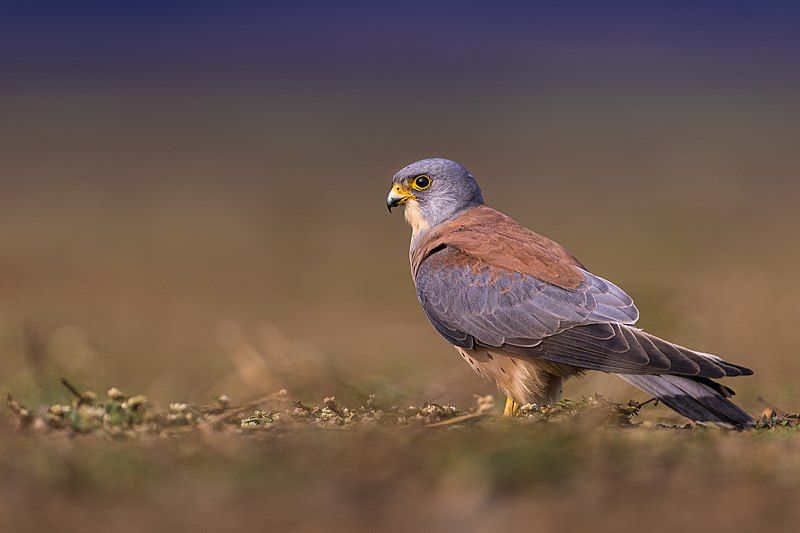
The Lesser Kestrel is a small falcon found in a wide range of countries, stretching from the Mediterranean to China and Mongolia. It breeds in these areas during the summer before migrating south for the winter.
It is usually seen in Africa and Pakistan during the colder months, and can sometimes even be seen as far away as India and Iraq. The Lesser Kestrel is rarer to the north of its breeding range, and its population is decreasing in Europe.
This species needs to be monitored carefully to protect its population and ensure its survival. Conservation efforts need to be put in place to protect the Lesser Kestrel and its habitat and to ensure that it remains a part of our world for many years to come.
| Kingdom | Animalia |
| Phylum | Chordata |
| Class | Aves |
| Order | Falconiformes |
| Family | Falconidae |
| Genus | Falco |
| Species | F. naumanni |
7. Black Bellied Plover
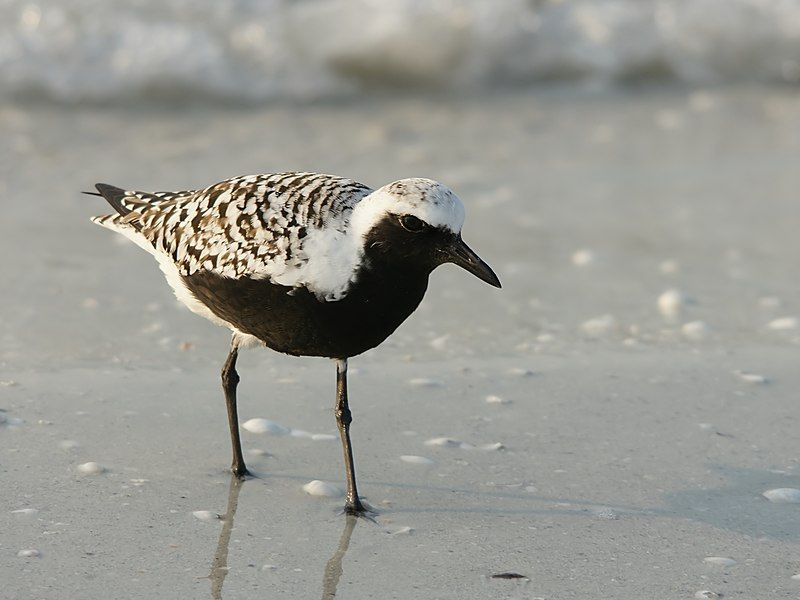
The grey plover, also known as the black-bellied plover in North America, is a large species of shorebird found all over the world. It is a long-distance migrant, spending the summer months in the Arctic regions where it breeds, and migrating to coastal areas in the winter.
This means that when not breeding, its range is nearly worldwide. The grey plover has a grey-brown back, a white belly, and a black band across its chest. Its wings are white underneath and black above, with a white patch on the side. Its bill is black and it has yellow legs.
It is a medium-sized bird, measuring between 23-27 cm in length and weighing between 80-130g. It feeds mainly on insects, mollusks, crustaceans, and worms, which it finds by probing in the mud. It is also known to feed on small fish, amphibians, and even some plant material.
It nests in shallow scrapes in the ground and lays three to four eggs. The grey plover is a common sight in many coastal areas and is an important species for shorebird conservation.
Its long-distance migration makes it particularly vulnerable to hunting and habitat destruction. It is listed as a species of least concern on the IUCN Red List, but its status is still being monitored.
| Kingdom | Animalia |
| Phylum | Chordata |
| Class | Aves |
| Order | Charadriiformes |
| Family | Charadriidae |
| Genus | Pluvialis |
| Species | P. squatarola |
8. Little Grebe
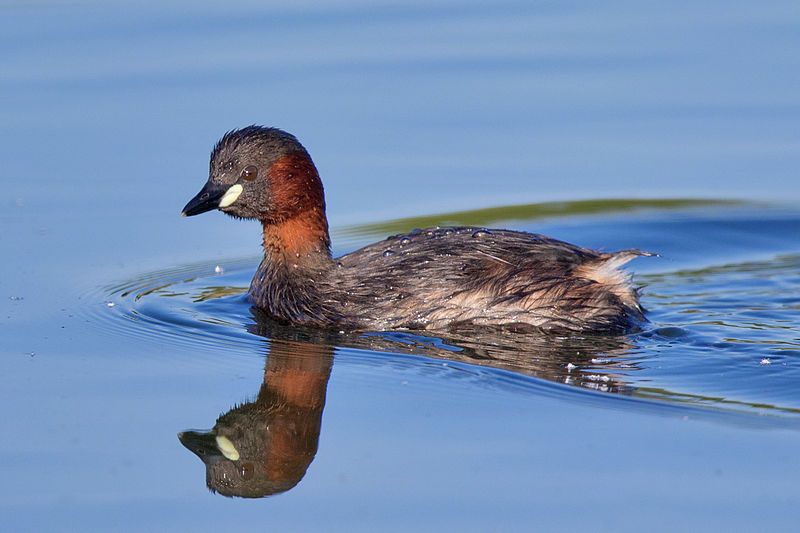
The little grebe, also known as dabchick, is a small water bird belonging to the grebe family. Its scientific name is derived from Ancient Greek and Latin words.
The genus name, takhus, is derived from the Ancient Greek word meaning “fast” and the Latin word bapto meaning “to sink under”.
The specific name, ruficollis, is formed from the Latin term for “red” (rufus) and the Modern Latin term for “necked” (-collis), which itself is derived from the Latin term for “neck” (collum). This reflects the bird’s characteristic red neck.
The little grebe is a highly adapted aquatic bird, and its name accurately reflects its behavior of quickly diving under the water’s surface.
| Kingdom | Animalia |
| Phylum | Chordata |
| Class | Aves |
| Order | Podicipediformes |
| Family | Podicipedidae |
| Genus | Tachybaptus |
| Species | T. ruficollis |
9. Great Cormorant
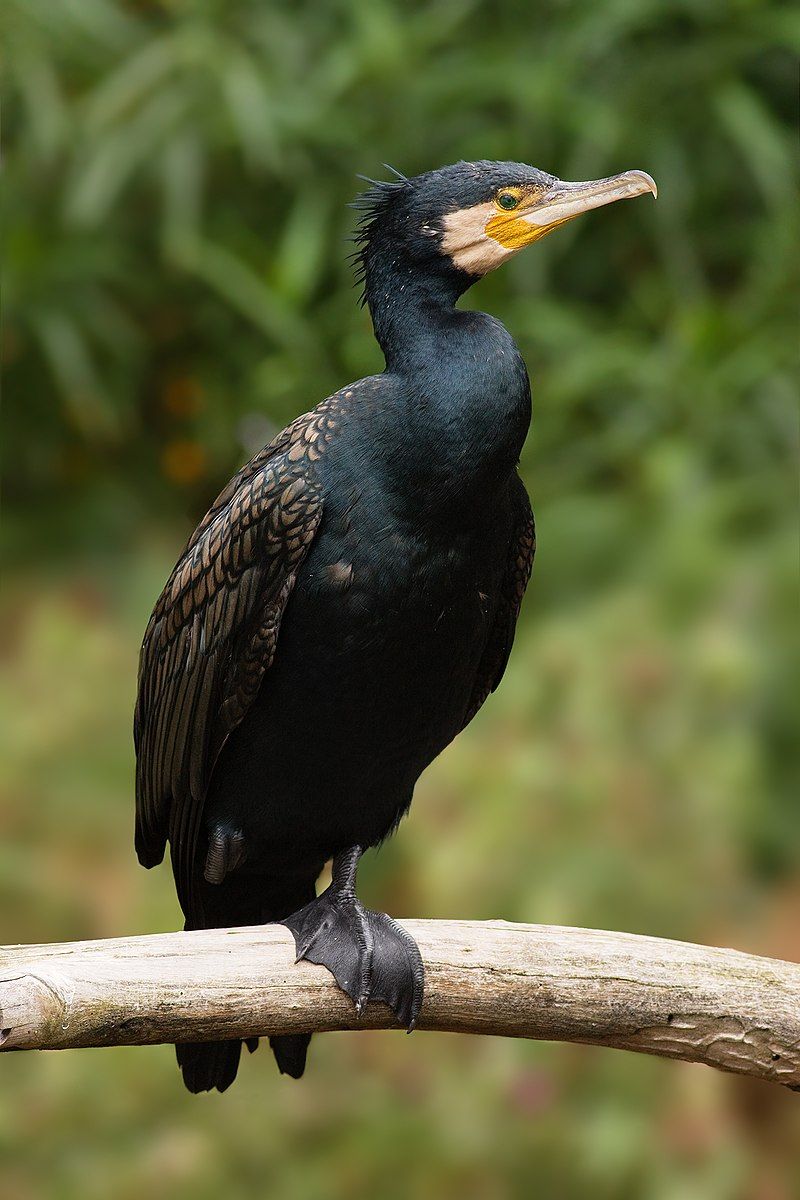
The great cormorant is a species of seabird that is found across a wide range of habitats, from the Northern Hemisphere to the Southern Hemisphere.
It has multiple common names, including the black shag or kawau in New Zealand, the great black cormorant in the Northern Hemisphere, the black cormorant in Australia, and the large cormorant in India.
It is a member of the cormorant family, which consists of seabirds that are adapted to swimming in the ocean and catching their prey with their powerful beaks. The great cormorant is a medium-sized seabird, measuring between 20 and 30 inches in length.
It has a large, powerful beak, which it uses to catch fish, crustaceans, and other small aquatic creatures. The wings are long and slender, helping the bird to fly easily at high speeds, and the tail is short and square-shaped.
Its feathers are blackish-brown, and it has a white patch on its throat. The great cormorant is typically found in coastal areas, but it will also venture inland to rivers and lakes.
It prefers to nest in colonies, often near cliffs and rocky islands, but it may also build its nest in trees. During the breeding season, it will lay three to five eggs, which are incubated for around four weeks.
The great cormorant is an important species in many regions, as it helps to maintain the health of aquatic ecosystems by controlling the population of small fish and other aquatic creatures.
It is also an important species for commercial and recreational fishing, as it provides a food source for humans. Unfortunately, its numbers have been declining in recent years due to habitat destruction, pollution, and overfishing.
| Kingdom | Animalia |
| Phylum | Chordata |
| Class | Aves |
| Order | Suliformes |
| Family | Phalacrocoracidae |
| Genus | Phalacrocorax |
| Species | P. carbo |
10. Guineafowls
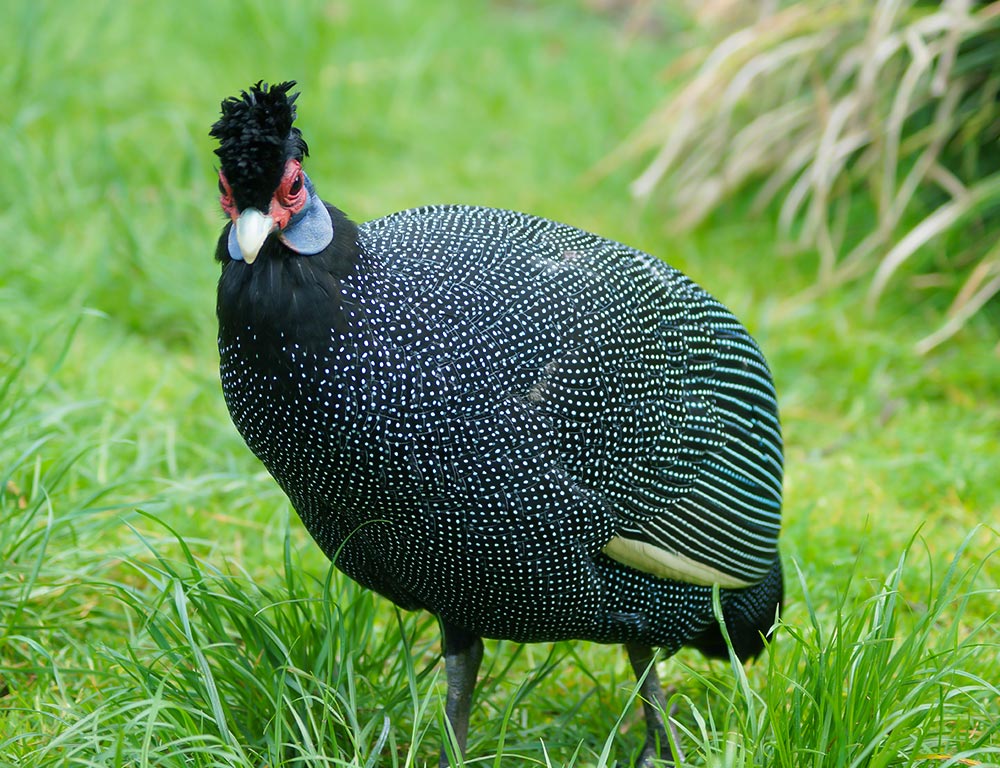
Guineafowl are birds from the family Numididae, which is part of the order Galliformes. This order contains various species of ground-feeding birds, such as pheasants, partridges, and quails.
Endemic to Africa, guineafowl are some of the oldest species of these ground-feeding birds.
When looking at the evolutionary tree of these birds, guineafowl are located after the Cracidae family, which includes chachalacas, guans, and curassows, and before the Odontophoridae family, which includes New World quails.
Therefore, guineafowl have been around for a long time and are an important part of the ground-feeding birds of Africa.
| Kingdom | Animalia |
| Phylum | Chordata |
| Class | Aves |
| Order | Galliformes |
| Family | Numididae |
11. African Pied Hornbill
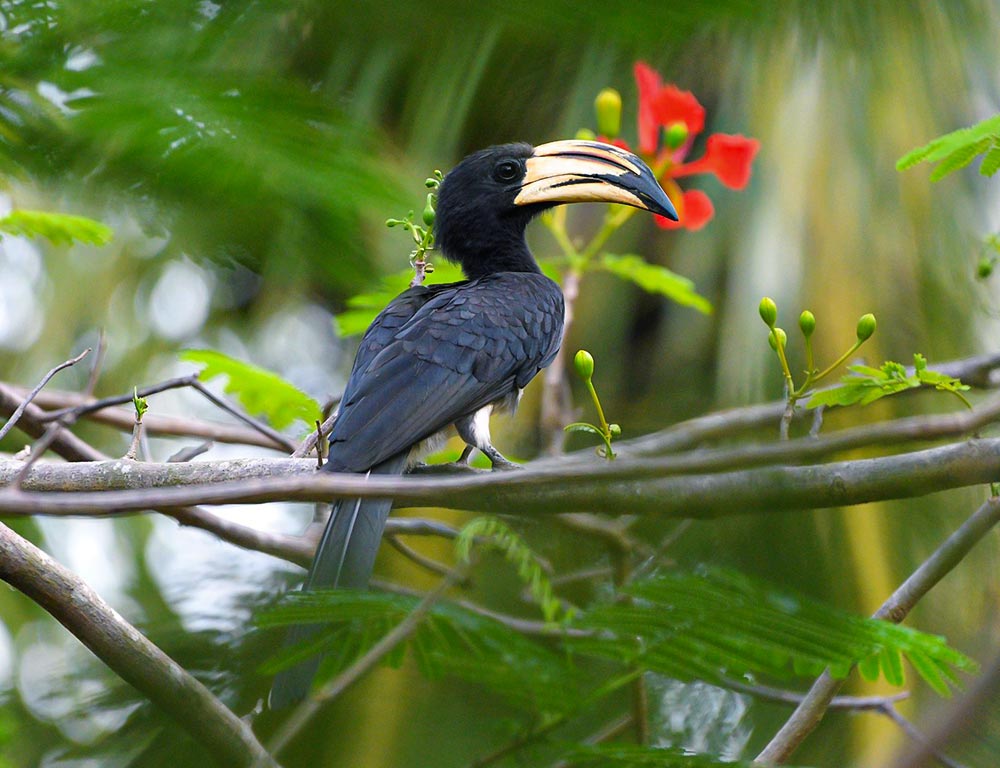
The Congo pied hornbill is a species of bird belonging to the family of tropical near-passerine birds, known as the hornbill family. This species is found in the Old World and is a common resident breeder in much of equatorial Africa.
Its range stretches from The Gambia in the west, all the way to Uganda in the east and northern Angola further south. The Congo pied hornbill has a distinctive appearance, with an overall black body and white patches on its wings and tail.
It has a curved yellow bill, which is a defining feature of hornbills, and yellow legs and feet. The male and female birds look similar, but the male has a larger bill than the female.
It also has a small red patch of skin on its throat. The Congo pied hornbill typically lives in lowland forests and can also be found in savannas and woodlands. It is a territorial species and will defend its territory from other hornbills.
During the breeding season, these birds build a nest in a tree cavity, which the female will then seal off with a wall of mud.
The female will then incubate the eggs and care for the young until they are ready to leave the nest. The Congo pied hornbill is an omnivore, meaning it eats both plant and animal matter.
Its diet consists of a variety of fruits, nuts, insects, small vertebrates, and even some eggs.
It is a vocal species and makes a variety of calls to communicate with other members of its species. The Congo pied hornbill is a species of least concern, meaning its population is currently stable.
However, it is still threatened by deforestation and habitat loss due to human activities. Conservation efforts are necessary to ensure the continued survival of this species.
| Kingdom | Animalia |
| Phylum | Chordata |
| Class | Aves |
| Order | Bucerotiformes |
| Family | Bucerotidae |
| Genus | Lophoceros |
| Species | L. fasciatus |
12. African Darter
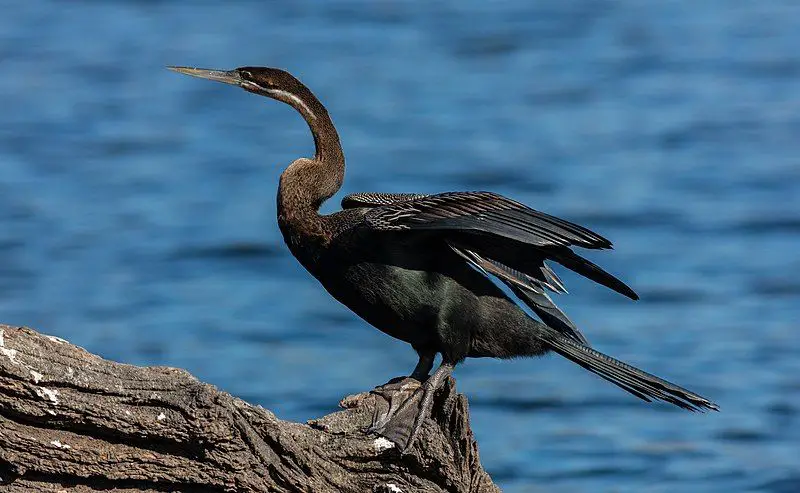
The African darter, also known as the snakebird, is a water bird commonly found throughout sub-Saharan Africa and in some parts of Iraq. This species of bird is known for its slender neck and long bill resembling a snake.
The African darter’s long neck allows them to feed underwater while keeping their head and body above the water’s surface. This species of bird is often seen in larger groups, as they are a very social species.
Their diet consists of mostly fish, frogs, and insects. The African darter is a medium-sized bird, ranging from 17 to 24 inches in length with a wingspan of 24 to 30 inches. The males are glossy black with white patches on their wings and tail.
The females are dull brown with white patches. This species of bird is usually found near lakes, rivers, and marshes.
They nest in tree cavities near the water’s edge, but they are also known to nest in reed beds near the water. Although the African darter is not considered threatened, their populations have been affected by habitat loss due to human activities, such as the expansion of urban areas and the construction of dams.
In addition, these birds are often hunted for their feathers, which are used for decorative purposes. Conservation efforts are in place to help protect this species of bird.
| Kingdom | Animalia |
| Phylum | Chordata |
| Class | Aves |
| Order | Suliformes |
| Family | Anhingidae |
| Genus | Anhinga |
| Species | A. rufa |
13. Arabian Bustard
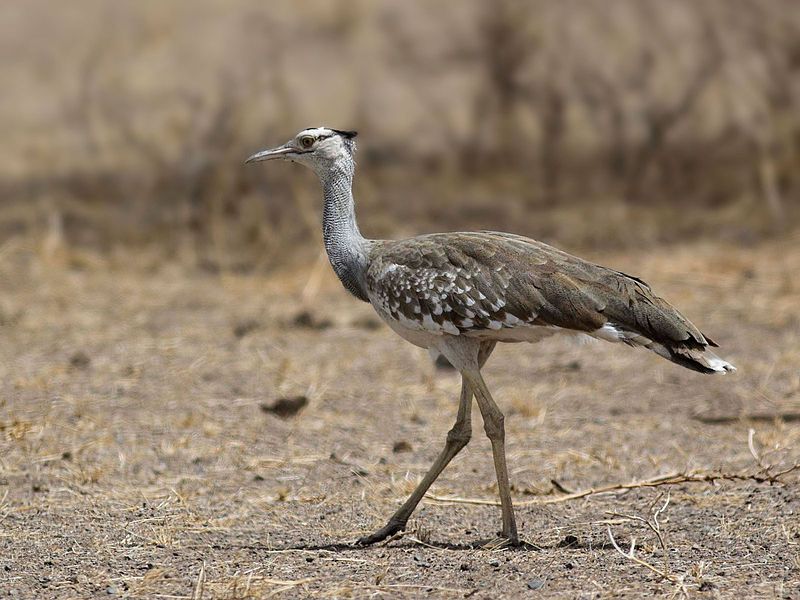
The Arabian bustard is a species of bustard that inhabits the Sahel region of Africa and southwestern Arabia. It is part of the large-bodied genus, Ardeotis, and is considered to be a fairly typical species within that group.
This species of bustard is not well-known, but it is believed to have characteristics that are similar to other members of its genus. Its habitat is mostly located in arid and semi-arid grasslands, with some areas of bushland and scrub.
It feeds on a wide variety of food sources, including insects, small reptiles, and some plant materials. The Arabian bustard is a relatively small species, with a wingspan of around 80 cm. It is a solitary species and tends to be active during the day.
It is an important part of the local ecosystem, playing an important role in maintaining the balance of the local environment.
| Kingdom | Animalia |
| Phylum | Chordata |
| Class | Aves |
| Order | Otidiformes |
| Family | Otididae |
| Genus | Ardeotis |
| Species | A. arabs |
14. Great White Pelican
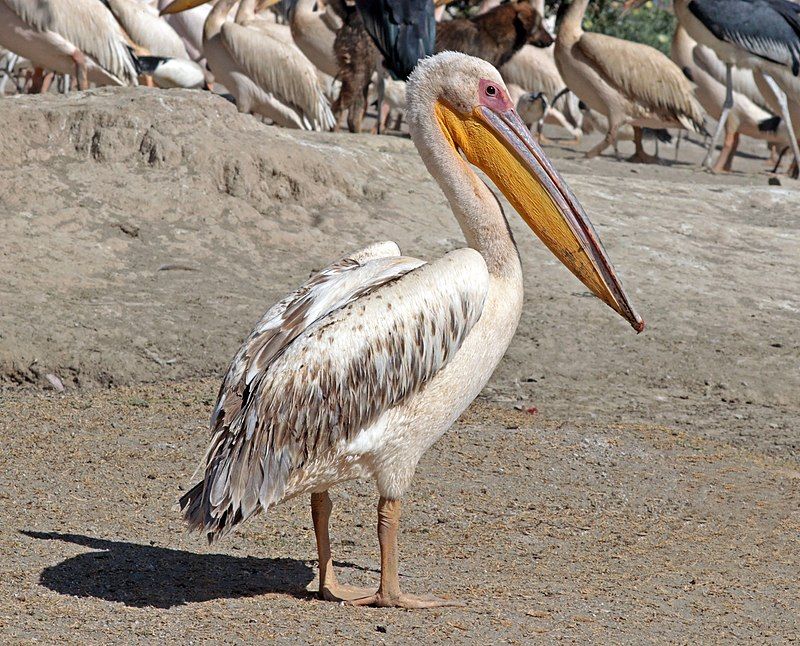
The great white pelican is a species of bird that belongs to the pelican family. It is also known by several other names such as eastern white pelican, rosy pelican, or white pelican.
This species of bird is found in a large geographical area that is spread across southeastern Europe, Asia, and Africa. It prefers to breed in wetlands and shallow lakes.
The great white pelican is a large bird, with a wingspan of around 2.5 meters and weighing up to 9 kilograms. It has a white plumage and a yellowish pouch on its bill, which it uses to scoop up prey while flying. It typically feeds on small fish, amphibians, and crustaceans.
The great white pelican is a migratory bird, usually found in large flocks, and it is known to travel across long distances. It is also a social bird, often seen in groups of up to several hundred individuals.
It is a species of least concern according to the International Union for Conservation of Nature and Natural Resources. In conclusion, the great white pelican is a species of bird that is found in a wide geographical area, spanning numerous countries in Asia, Europe, and Africa.
It is a large bird, with a wingspan of up to 2.5 meters, and it feeds on small fish, amphibians, and crustaceans. It is a migratory bird, usually found in large flocks, and it is listed as a species of least concern.
| Kingdom | Animalia |
| Phylum | Chordata |
| Class | Aves |
| Order | Pelecaniformes |
| Family | Pelecanidae |
| Genus | Pelecanus |
| Species | P. onocrotalus |
15. Black Crake
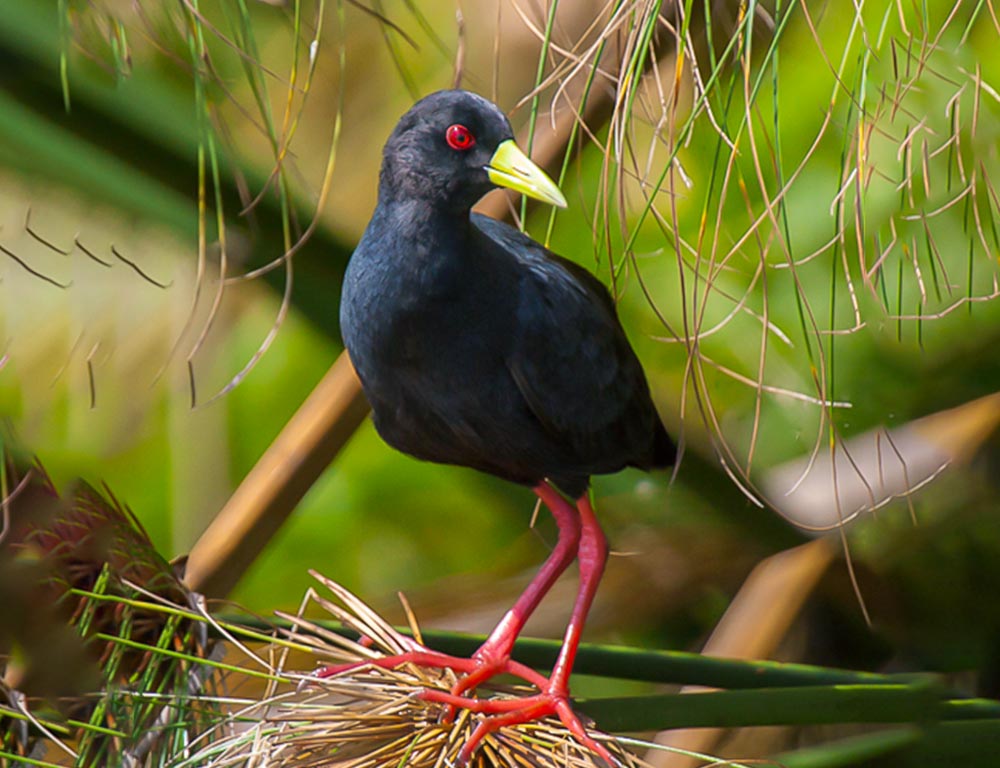
The black crake is a species of bird from the Rallidae family found in sub-Saharan Africa. It is a waterbird, meaning it is found near bodies of water such as ponds, lakes, rivers, and marshes. The black crake is found throughout sub-Saharan Africa, except in very arid areas.
It may undertake some seasonal movements in the parts of its range that are subject to drought. Currently, no subspecies of the black crake have been described, meaning there is only one species of black crake.
The black crake is a rather small species of bird, typically measuring only about 27-30 cm in length. It has a black body, with a white patch on its nape and a light grey or white belly. Its wings are black, with white bars and a white tip.
It has a short, stubby bill with a yellowish color, and its legs are a yellowish-orange color. The black crake is usually seen alone or in pairs and is shy and secretive. It is a rather solitary species, preferring to stay hidden in dense vegetation or in the reeds near water.
The black crake feeds mainly on insects, aquatic invertebrates, and seeds. It prefers to forage on the ground but also eats from low vegetation. During the breeding season, from October to March, the black crake builds a nest in reeds close to water.
It lays a clutch of 4-5 eggs, which are incubated by both parents. The black crake is a species of least concern, meaning it is not endangered or threatened.
However, its population is declining due to the destruction of its habitat, which is mainly caused by human activities such as farming and urban development. As a result, conservation measures are needed to ensure the long-term survival of the species.
| Kingdom | Animalia |
| Phylum | Chordata |
| Class | Aves |
| Order | Gruiformes |
| Family | Rallidae |
| Genus | Zapornia |
| Species | Z. flavirostra |
16. Common Pochard
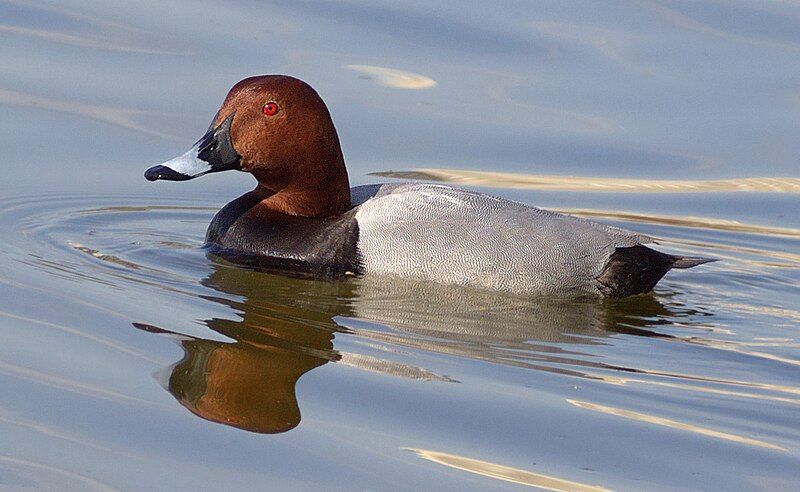
The common pochard is a medium-sized diving duck that is found in many different parts of the world. Its scientific name is derived from the ancient Greek language. The name aithuia is an unidentified seabird that is referenced by authors such as Hesychius and Aristotle.
Additionally, the Latin word ferina is derived from the word ferus which means “wild”. This is to indicate that the common pochard is a wild duck and not a domesticated one. The combination of these two words is what gives the duck its scientific name.
The common pochard is an important species in many different ecosystems. It has adapted to live in both fresh and saltwater and can be found in a variety of environments. Its primary diet consists of aquatic plants, small fish, and invertebrates.
The common pochard is also a keystone species in many areas as it helps to maintain the balance of the aquatic food web. Overall, the common pochard is a unique and important species in many different environments.
Its scientific name is derived from the ancient Greek language and is indicative of its wild nature. This species is vital to the balance of many aquatic ecosystems and provides many benefits to its environment.
| Kingdom | Animalia |
| Phylum | Chordata |
| Class | Aves |
| Order | Anseriformes |
| Family | Anatidae |
| Genus | Aythya |
| Species | A. ferina |
17. Ferruginous Duck
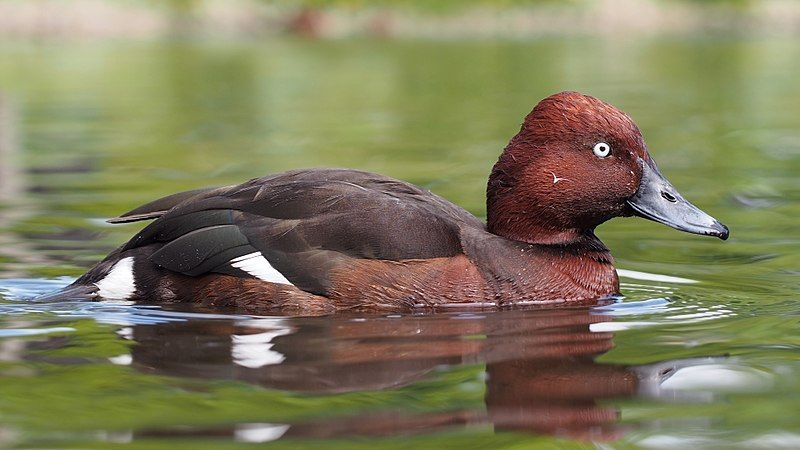
The ferruginous duck is a species of diving duck that is found across a wide range in Eurosiberia. It is also known by several other names including ferruginous pochard, common white-eye, or white-eyed pochard.
Its scientific name is derived from the Greek word aithuia, which was used to refer to an unidentified seabird, and the Russian word nyrok, which means duck.
This species of duck is considered to be medium-sized and can be easily identified by its distinctive rusty-brown plumage. The ferruginous duck has a wide range of habitats which includes tundra, wetlands, lakes, and ponds.
As a diving duck, it feeds mainly on aquatic plants, insects, and mollusks. They are also known to forage on land, eating grains, berries, and even small frogs.
The ferruginous duck is known to form monogamous pairs during the breeding season, and the female will usually lay around five to eight eggs in a single clutch.
The eggs will hatch in about four weeks and the young ducks will stay with their parents until they are ready to migrate. The ferruginous duck is an important species for many ecosystems as it helps to maintain the balance between predator and prey populations.
Unfortunately, its population is in decline due to a combination of factors such as habitat loss, overhunting, and pollution. Conservation efforts are being made to help protect this species and ensure its future survival.
| Kingdom | Animalia |
| Phylum | Chordata |
| Class | Aves |
| Order | Anseriformes |
| Family | Anatidae |
| Genus | Aythya |
| Species | A. nyroca |
18. Phasianidae
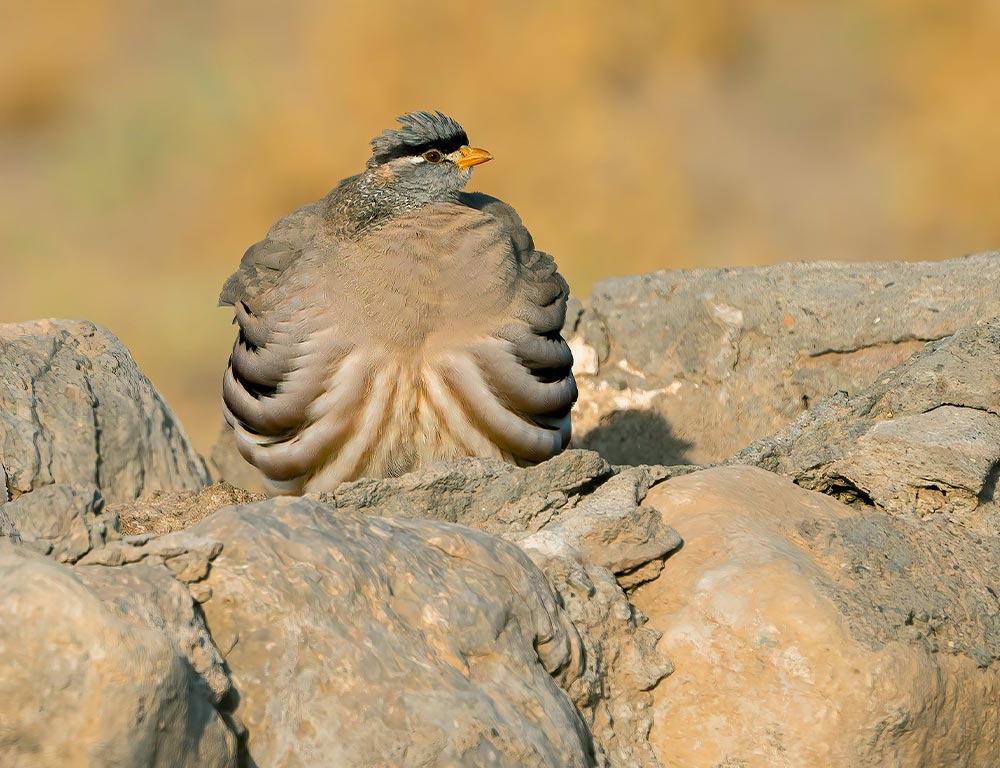
The Phasianidae family is a large group of birds that are mainly ground-dwelling. This family includes a variety of birds such as pheasants, partridges, junglefowl, chickens, turkeys, Old World quail, and peafowl.
These birds are popularly used for game hunting and are very important to the ecosystem. The family consists of 185 species divided into 54 genera.
This means that the family is made up of a large variety of birds, with each species being closely related in terms of genetic makeup. The birds in this family are typically characterized by having long, powerful legs, and stout bodies.
These features make them well-suited to survive in their natural habitats. The Phasianidae family of birds is important for its many uses. Not only are they popularly used for game hunting, but they are also important for their role in the food chain.
These birds are a food source for many different animals, and they help to maintain balance in the ecosystem. Overall, the Phasianidae family is a large group of birds that are important to the ecosystem.
They are used for game hunting, as well as providing food for other animals. This family consists of 185 species divided into 54 genera, showing the vast variety of birds in this family.
| Kingdom | Animalia |
| Phylum | Chordata |
| Class | Aves |
| Order | Galliformes |
| Family | Phasianidae |
19. Hooded Vulture
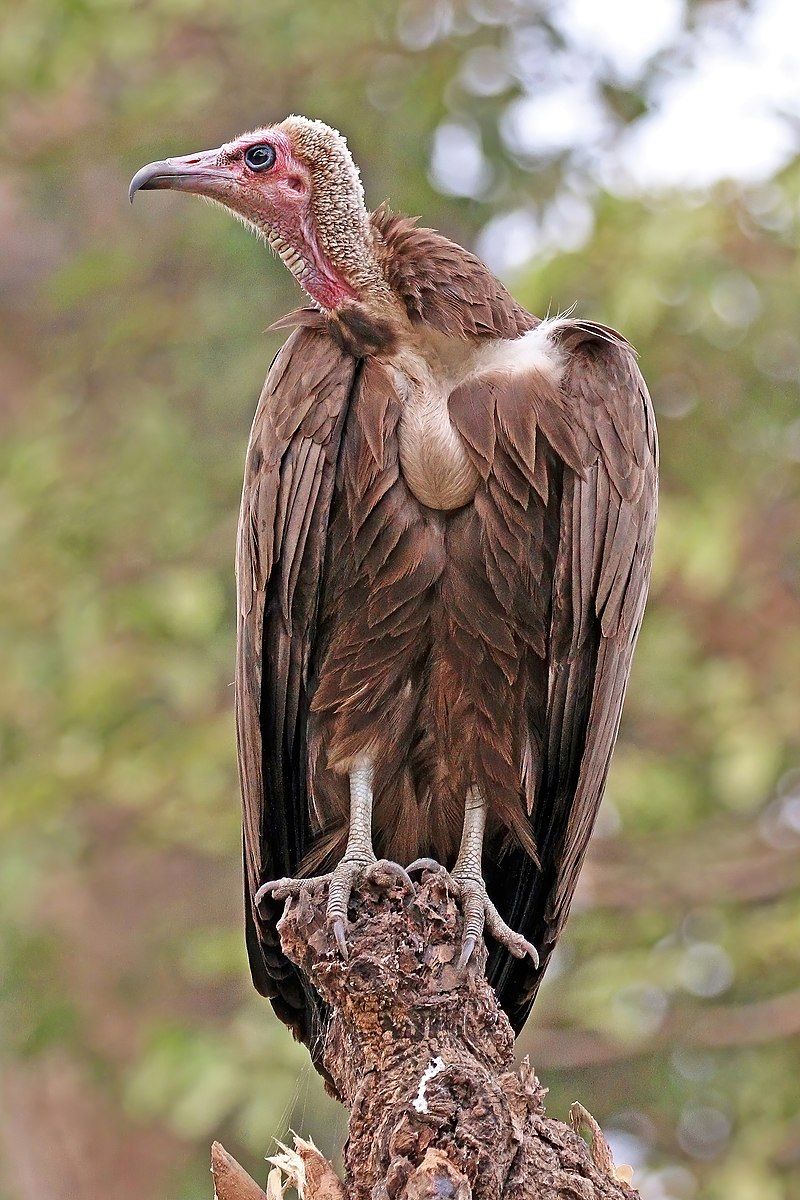
The hooded vulture is a type of Old World vulture which belongs to the order Accipitriformes. This order includes notable birds such as eagles, kites, buzzards, and hawks.
Within this order, the hooded vulture occupies its own genus, Necrosyrtes, which is closely related to the larger Gyps genus. Both these genera are part of the Aegypiinae subfamily of Old World vultures.
This subfamily is made up of 22 species of vultures found in Africa and Asia, and the hooded vulture is the only member of the Necrosyrtes genus. The hooded vulture is quite small compared to its relatives in the Gyps genus, typically weighing less than 1 kilogram.
It is predominantly black or gray with a white collar around its neck, which gives it its namesake. It has a body length of about 60 centimeters and a wingspan of up to 140 centimeters.
Its diet consists mainly of carrion, although it will also eat insects, eggs, small reptiles, and scavenged scraps from other animals. The hooded vulture is a monogamous species, and will often form long-term pair bonds.
Its nesting habits are unique, as it does not build nests and instead lays its eggs directly on the ground or in other hollows. It is considered to be a near-threatened species due to habitat destruction and persecution by humans.
| Kingdom | Animalia |
| Phylum | Chordata |
| Class | Aves |
| Order | Accipitriformes |
| Family | Accipitridae |
| Genus | Necrosyrtes |
| Species | N. monachus |
20. White-backed Vulture
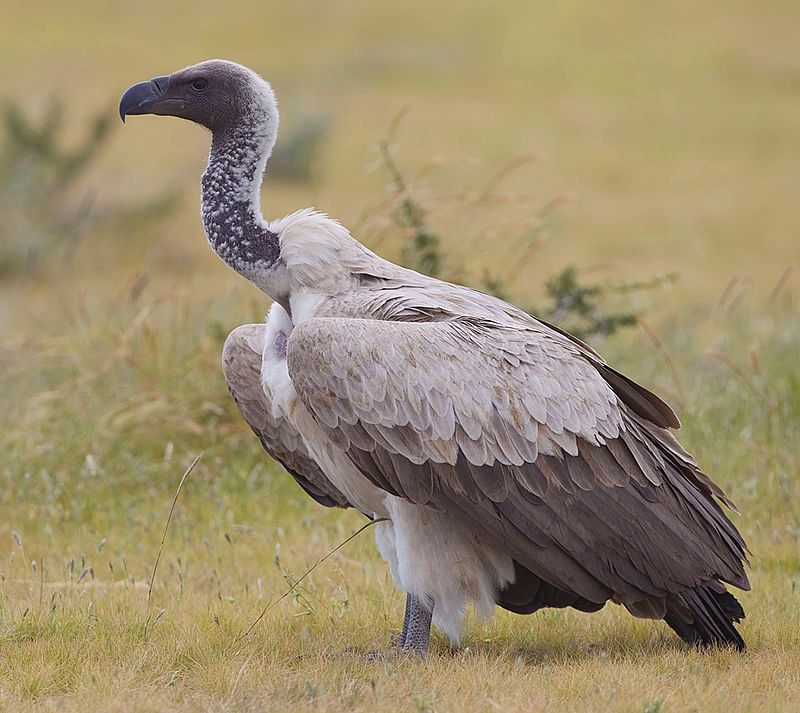
The white-backed vulture is a species of vulture found in the Old World. It is part of the Accipitridae family, which is a family of large birds of prey that includes eagles, kites, buzzards, and hawks.
This species of vulture is the most common in the continent of Africa, which is home to a variety of unique species of fauna. The white-backed vulture is a large bird of prey with a white back and wings and a black or grey body.
It has a bare head and neck, and a short, hooked beak. This species of vulture primarily feeds on carrion, but it will also scavenge when necessary. It is a social bird that typically travels in flocks, and is an important part of the African ecosystem.
| Kingdom | Animalia |
| Phylum | Chordata |
| Class | Aves |
| Order | Accipitriformes |
| Family | Accipitridae |
| Genus | Gyps |
| Species | G. africanus |
21. Pelicans
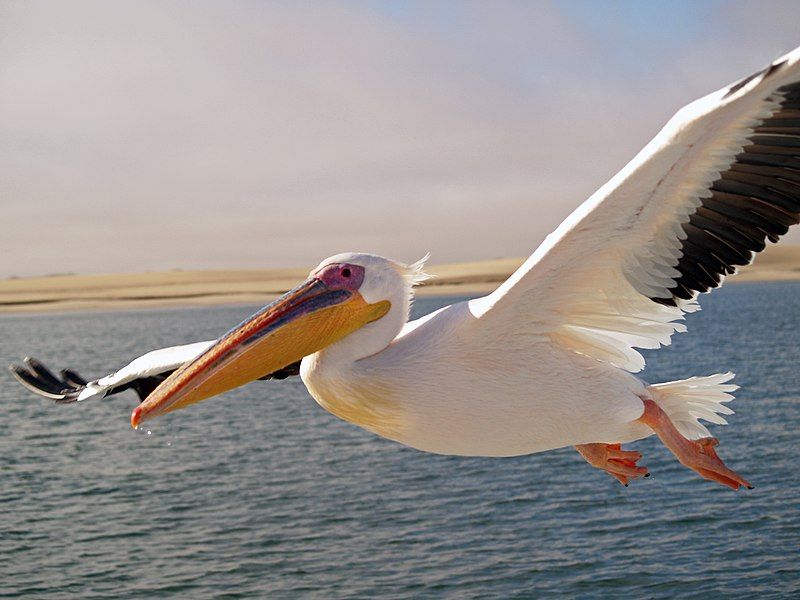
Pelicans are a large family of water birds, classified under the genus Pelecanidae. They are known for their long beaks and large throat pouches, which are used to scoop up prey and drain the water before swallowing.
These birds are mostly pale in color, though some species have brown or even Peruvian plumage. Their plumage helps them to blend in with their natural habitats, making them difficult to spot in the wild.
The long beak of the pelican is also an adaptation that helps them to catch and eat their favorite food, which includes fish, crustaceans, amphibians, and even small mammals.
The pouch on their throat is specially designed to hold water, allowing them to stay hydrated while they hunt. Pelicans are primarily found near bodies of water, such as lakes, rivers, and coasts. They are social birds and often flock together in large groups.
Despite their size, pelicans are quite graceful and powerful in flight, and they can often be seen soaring high above the water in search of food.
| Kingdom | Animalia |
| Phylum | Chordata |
| Class | Aves |
| Order | Pelecaniformes |
| Family | Pelecanidae |
| Genus | Pelecanus |
22. Black Crowned Crane
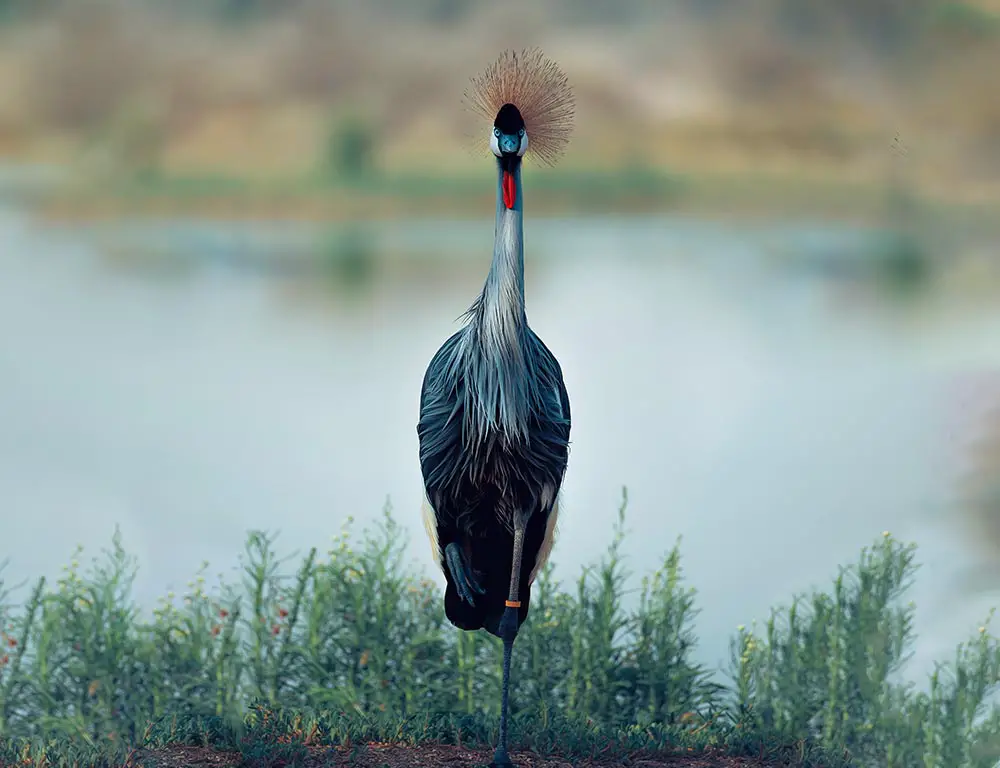
The black-crowned crane is a majestic and noble species of bird that belongs to the family Gruidae. It is a sister species to the grey-crowned crane and the two birds have many similarities. The black crowned crane is easily identified by its unique and striking appearance.
It has a black body with white facial markings and a golden crown of bristly feathers that stands atop its head. This golden crown is the bird’s most notable feature and gives it its distinctive name.
The black crowned crane is an impressive and powerful bird that stands regally at an average height of up to five feet. It has a wingspan of up to seven feet and is capable of flight.
The bird is a symbol of luck, longevity, and peace in many parts of the world, making it a highly respected species of bird. The black crowned crane is a fascinating creature that is sure to capture the attention of anyone lucky enough to observe one.
| Kingdom | Animalia |
| Phylum | Chordata |
| Class | Aves |
| Order | Gruiformes |
| Family | Gruidae |
| Genus | Balearica |
| Species | B. pavonina |
23. Black-winged Stilt
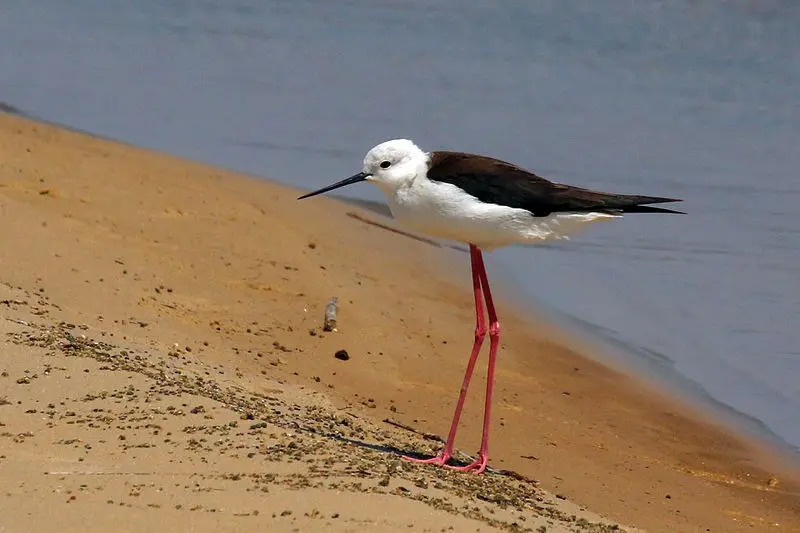
The black-winged stilt is a species of wading bird belonging to the avocet and stilt family. It is distributed widely across a variety of habitats, from wetlands to estuaries, and even saline and brackish waters.
It is known for its extremely long legs, which enable it to wade in very shallow waters. Its scientific name is H. himantopus, though this is sometimes used to refer to one single, almost universally distributed species.
Compared to other wading birds, the black-winged stilt is relatively small in size, with a short, pointed bill and a black head with a white crown. Its wings are black with a white patch near the shoulder, while its legs are a bright pinkish-red in color.
It feeds mainly on insects, crustaceans, and other small aquatic animals, which it finds while wading in shallow waters. The black-winged stilt is an important part of many wetland ecosystems, as it helps to keep the water clean by consuming a range of small aquatic animals.
| Kingdom | Animalia |
| Phylum | Chordata |
| Class | Aves |
| Order | Charadriiformes |
| Family | Recurvirostridae |
| Genus | Himantopus |
| Species | H. himantopus |
24. Chestnut-bellied Sandgrouse
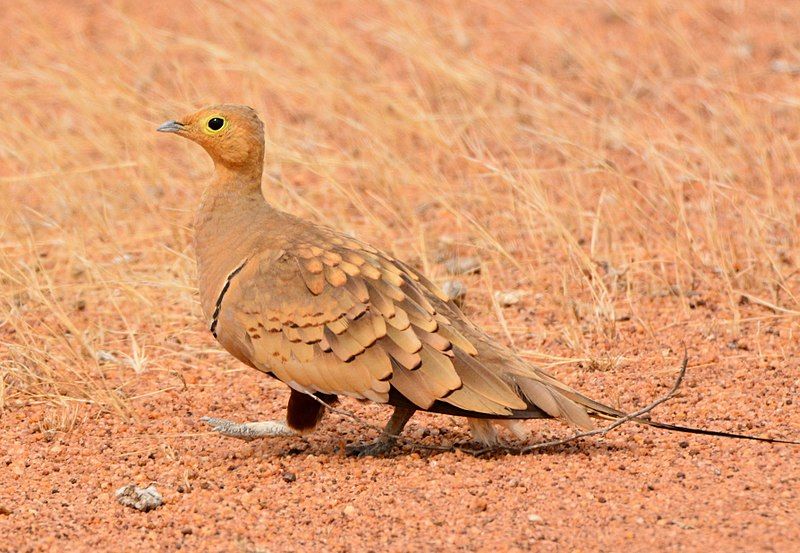
The chestnut-bellied sandgrouse is a species of bird belonging to the sandgrouse family. It is found in northern and central Africa, and in western and southern Asia.
It is a sedentary species, meaning it can stay in one area for a long period, but it can also be nomadic, meaning that it can migrate to different areas.
There are six recognized subspecies of this bird, all of which differ slightly in terms of their physical features, such as size, color, and plumage.
The chestnut-bellied sandgrouse has a distinctive chestnut color on its belly, which is one of the main ways to identify this species from other sandgrouse. It is a medium-sized bird, with a length of around 28-35 cm and a wingspan of around 20-25 cm.
Its diet consists of a variety of plants and insects, and it usually forages for food on the ground. It is a sociable bird and usually gathers in groups of up to 30 birds when foraging.
The chestnut-bellied sandgrouse is an important species for conservation, and its population is currently stable.
| Kingdom | Animalia |
| Phylum | Chordata |
| Class | Aves |
| Order | Pterocliformes |
| Family | Pteroclidae |
| Genus | Pterocles |
| Species | P. exustus |
Conclusion
The birds of Bazèga are an invaluable natural asset that brings beauty to the region. They provide a wealth of ecological benefits and contribute to the local biodiversity.
With careful consideration and management of their environment, the birds of Bazèga can continue to thrive and bring joy to the people of the region.